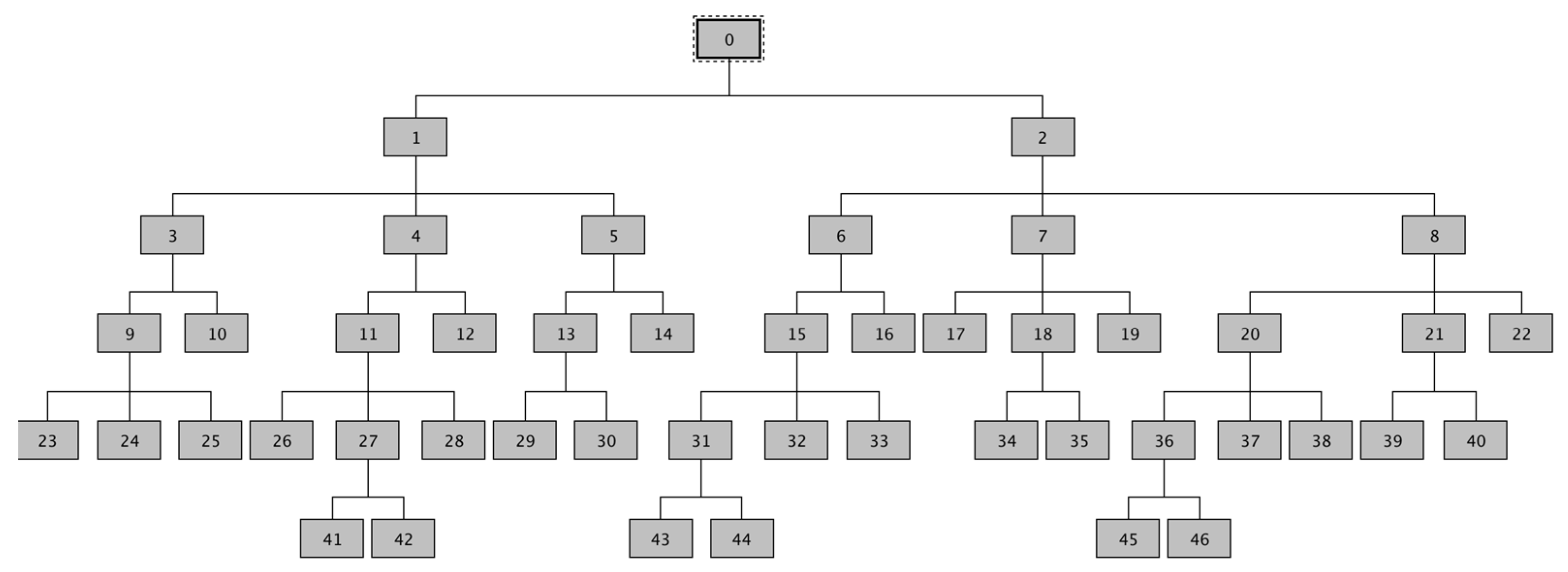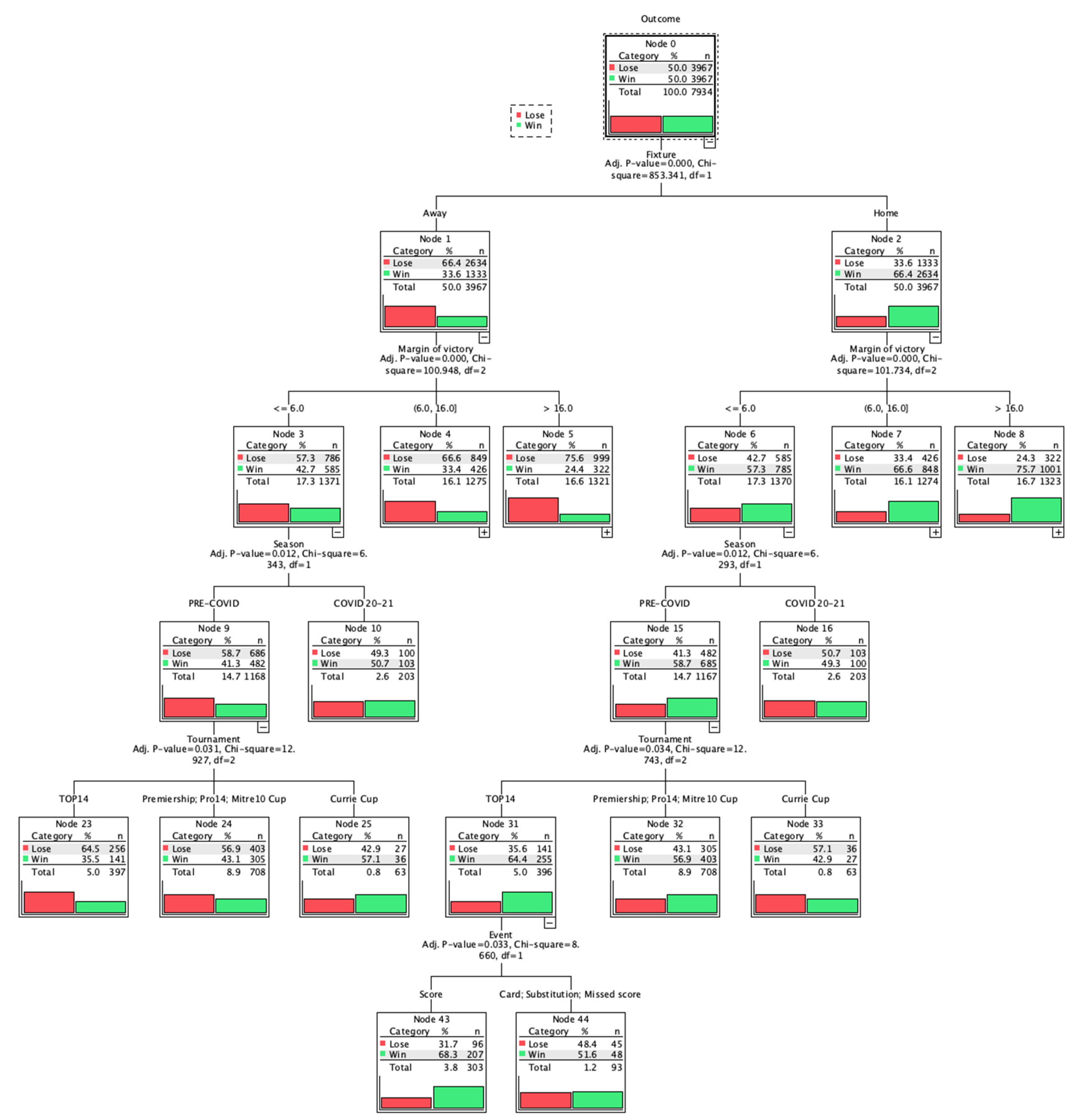A Machine Learning Approach to Analyze Home Advantage during COVID-19 Pandemic Period with Regards to Margin of Victory and to Different Tournaments in Professional Rugby Union Competitions
Abstract
:1. Introduction
2. Materials and Methods
2.1. Design
2.2. Methodology
2.3. Data Analysis
3. Results
4. Discussion
5. Conclusions
Supplementary Materials
Author Contributions
Funding
Institutional Review Board Statement
Informed Consent Statement
Data Availability Statement
Conflicts of Interest
References
- Gómez, M.A.; Pollard, R.; Luis-Pascual, J.C. Comparison of the Home Advantage in Nine Different Professional Team Sports in Spain. Percept. Mot. Skills 2011, 113, 150–156. [Google Scholar] [CrossRef]
- Pollard, R.; Pollard, G. Home Advantage in Soccer. A Review of Its Existence and Causes. Int. J. Soccer Sci. 2005, 3, 31–34. [Google Scholar]
- Nevill, A.M.; Holder, R.L. Home Advantage in Sport. An Overview of Studies on the Advantage of Playing at Home. Sport. Med. 1999, 28, 221–236. [Google Scholar] [CrossRef] [PubMed]
- Thomas, S.; Reeves, C.; Bell, A. Home Advantage in the Six Nations Rugby Union Tournament. Percept. Mot. Skills 2008, 106, 113–116. [Google Scholar] [CrossRef] [PubMed]
- García, M.S.; Aguilar, Ó.G.; Lazo, J.C.V.; Marques, P.S.; Romero, J.J.F. Home Advantage in Home Nations, Five Nations and Six Nations Rugby Tournaments (1883–2011). Int. J. Perform. Anal. Sport 2013, 13, 51–63. [Google Scholar] [CrossRef]
- Dawson, P.; Massey, P.; Downward, P. Television Match Officials, Referees, and Home Advantage: Evidence from the European Rugby Cup. Sport Manag. Rev. 2020, 23, 443–454. [Google Scholar] [CrossRef]
- Morton, R.H. Home Advantage in Southern Hemisphere Rugby Union: National and International. J. Sports Sci. 2006, 24, 495–499. [Google Scholar] [CrossRef]
- Du Preez, M.; Lambert, M. Travel Fatigue and Home Ground Advantage in South African Super 12 Rugby Teams. S. Afr. J. Sports Med. 2007, 19. [Google Scholar] [CrossRef] [Green Version]
- Reuters. Impact of COVID-19 Pandemic on Sports Events around the World. 2020. Available online: https://cn.reuters.com/article/health-coronavirus-sport-idINKBN23I1WL (accessed on 15 July 2021).
- Fioravanti, F.; Delbianco, F.; Tohmé, F. Home Advantage and Crowd Attendance: Evidence from Rugby during the COVID 19 Pandemic. arXiv 2021, arXiv:2105.01446. [Google Scholar]
- Gómez, M.A.; Ibáñez, S.J.; Parejo, I.; Furley, P. The Use of Classification and Regression Tree When Classifying Winning and Losing Basketball Teams. Kinesiology 2017, 49, 47–56. [Google Scholar] [CrossRef] [Green Version]
- Ungureanu, A.N.; Brustio, P.R.; Mattina, L.; Lupo, C. “How” Is More Important than “How Much” for Game Possession in Elite Northern Hemisphere Rugby Union. Biol. Sport 2019, 36, 265–272. [Google Scholar] [CrossRef] [PubMed]
- Parmar, N.; James, N.; Hughes, M.; Jones, H.; Hearne, G. Team Performance Indicators That Predict Match Outcome and Points Difference in Professional Rugby League. Int. J. Perform. Anal. Sport 2017, 17, 1044–1056. [Google Scholar] [CrossRef]
- Van Rooyen, M.K. A Statistical Analysis of Tackling Performance during International Rugby Union Matches from 2011. Int. J. Perform. Anal. Sport 2012, 12, 517–530. [Google Scholar] [CrossRef]
- Jones, N.M.P.; Mellalieu, S.D.; James, N.; Moise, J. Contact Area Playing Styles of Northern and Southern Hemisphere International Rugby Union Teams. In Performance Analysis of Sport VI; Centre for Performance, Univeristy of Wales: Cardiff, Wales, 2004; pp. 114–119. [Google Scholar]
- Ungureanu, A.N.; Condello, G.; Pistore, S.; Conte, D.; Lupo, C. Technical and Tactical Aspects in Italian Youth Rugby Union in Relation to Different Academies, Regional Tournaments, and Outcomes. J. Strength Cond. Res. 2019, 33, 1557–1569. [Google Scholar] [CrossRef] [PubMed]
- Haghighat, M.; Rastegari, H.; Nourafza, N.; Branch, N.; Esfahan, I. A Review of Data Mining Techniques for Result Prediction in Sports. Adv. Comput. Sci. Int. J. 2013, 2, 7–12. [Google Scholar]
- Biggs, D.; De Ville, B.; Suen, E. A Method of Choosing Multiway Partitions for Classification and Decision Trees. J. Appl. Stat. 1991, 18, 49–62. [Google Scholar] [CrossRef]
- Blockeel, H.; Struyf, J. Efficient Algorithms for Decision Tree Cross-Validation. J. Mach. Learn. Res. 2002, 3, 621–650. [Google Scholar]
- Parmar, N.; James, N.; Hearne, G.; Jones, B. Using Principal Component Analysis to Develop Performance Indicators in Professional Rugby League. Int. J. Perform. Anal. Sport 2018, 18, 938–949. [Google Scholar] [CrossRef]
- Woods, C.T.; Sinclair, W.; Robertson, S. Explaining Match Outcome and Ladder Position in the National Rugby League Using Team Performance Indicators. J. Sci. Med. Sport 2017, 20, 1107–1111. [Google Scholar] [CrossRef]
- Bennett, M.; Bezodis, N.; Shearer, D.A.; Locke, D.; Kilduff, L.P. Descriptive Conversion of Performance Indicators in Rugby Union. J. Sci. Med. Sport 2019, 22, 330–334. [Google Scholar] [CrossRef] [Green Version]
- Chambers, R.M.; Gabbett, T.J.; Gupta, R.; Josman, C.; Bown, R.; Stridgeon, P.; Cole, M.H. Automatic Detection of One-on-One Tackles and Ruck Events Using Microtechnology in Rugby Union. J. Sci. Med. Sport 2019, 22, 827–832. [Google Scholar] [CrossRef] [PubMed]
- Vaz, L.; van Rooyen, M.; Sampaio, J. Rugby Game-Related Statistics That Discriminate between Winning and Losing Teams in IRB and Super Twelve Close Games. J. Sport. Sci. Med. 2010, 9, 51. [Google Scholar]
- Croft, H.; Lamb, P.; Middlemas, S. The Application of Self-Organising Maps to Performance Analysis Data in Rugby Union. Int. J. Perform. Anal. Sport 2017, 15, 1037–1046. [Google Scholar] [CrossRef]
- Coughlan, M.; Mountifield, C.; Sharpe, S.; Mara, J.K. How They Scored the Tries: Applying Cluster Analysis to Identify Playing Patterns That Lead to Tries in Super Rugby. Int. J. Perform. Anal. Sport 2019, 19, 435–451. [Google Scholar] [CrossRef]
- De’Ath, G.; Fabricius, K.E. Classification and Regression Trees: A Powerful yet Simple Technique for Ecological Data Analysis. Ecology 2000, 81, 3178–3192. [Google Scholar] [CrossRef]
- Rokach, L.; Maimon, O. Decision trees. In Data Mining and Knowledge Discovery Handbook; Springer: Berlin/Heidelberg, Germany, 2005; pp. 165–192. [Google Scholar]
- Song, Y.; Lu, Y. Decision Tree Methods: Applications for Classification and Prediction. Shanghai Arch. Psychiatry 2015, 27, 130. [Google Scholar] [CrossRef]
- Colomer, C.M.E.; Pyne, D.B.; Mooney, M.; McKune, A.; Serpell, B.G. Performance Analysis in Rugby Union: A Critical Systematic Review. Sport. Med. Open 2020, 6, 4. [Google Scholar] [CrossRef] [PubMed]
- Schoeman, R.; Schall, R. Comparison of Match-Related Performance Indicators between Major Professional Rugby Competitions. Int. J. Sport. Sci. Coach. 2019, 14, 344–354. [Google Scholar] [CrossRef]
- Hogan, V.; Massey, P.; Massey, S. Competitive Balance and Match Attendance in European Rugby Union Leagues. Econ. Soc. Rev. 2013, 44, 425–446. [Google Scholar]
- Barros, C.P.; Bertrand, G.; Botti, L.; Tainsky, S. Cost Efficiency of French Rugby Clubs. Appl. Econ. 2014, 46, 2721–2732. [Google Scholar] [CrossRef]
- Ungureanu, A.N.; Brustio, P.R.; Lupo, C. Technical and Tactical Effectiveness Is Related to Time-Motion Performance in Elite Rugby. J. Sports Med. Phys. Fitness 2021, 61, 167–174. [Google Scholar] [CrossRef]
- Bilek, G.; Ulas, E. Predicting Match Outcome According to the Quality of Opponent in the English Premier League Using Situational Variables and Team Performance Indicators. Int. J. Perform. Anal. Sport 2019, 19, 930–941. [Google Scholar] [CrossRef]


Publisher’s Note: MDPI stays neutral with regard to jurisdictional claims in published maps and institutional affiliations. |
© 2021 by the authors. Licensee MDPI, Basel, Switzerland. This article is an open access article distributed under the terms and conditions of the Creative Commons Attribution (CC BY) license (https://creativecommons.org/licenses/by/4.0/).
Share and Cite
Ungureanu, A.N.; Lupo, C.; Brustio, P.R. A Machine Learning Approach to Analyze Home Advantage during COVID-19 Pandemic Period with Regards to Margin of Victory and to Different Tournaments in Professional Rugby Union Competitions. Int. J. Environ. Res. Public Health 2021, 18, 12711. https://doi.org/10.3390/ijerph182312711
Ungureanu AN, Lupo C, Brustio PR. A Machine Learning Approach to Analyze Home Advantage during COVID-19 Pandemic Period with Regards to Margin of Victory and to Different Tournaments in Professional Rugby Union Competitions. International Journal of Environmental Research and Public Health. 2021; 18(23):12711. https://doi.org/10.3390/ijerph182312711
Chicago/Turabian StyleUngureanu, Alexandru Nicolae, Corrado Lupo, and Paolo Riccardo Brustio. 2021. "A Machine Learning Approach to Analyze Home Advantage during COVID-19 Pandemic Period with Regards to Margin of Victory and to Different Tournaments in Professional Rugby Union Competitions" International Journal of Environmental Research and Public Health 18, no. 23: 12711. https://doi.org/10.3390/ijerph182312711






